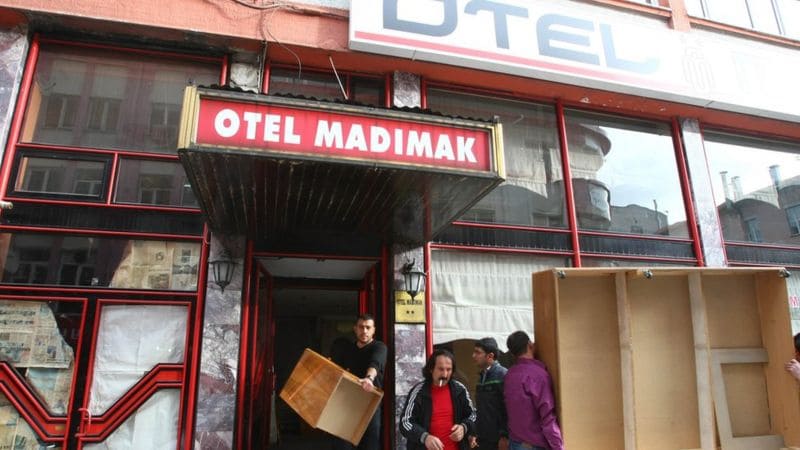The day was July 2, 1993. A group of 35 people was burnt alive by radical Islamists, belonging to the Sunni sect of Islam, in Turkey.
The only mistake that the deceased committed was that they were followers of Alevism. Each year, thousands of people gather in the city of Sivas to remember the ones who perished in one of Turkey’s deadliest massacres, the Sivas Massacre.
The followers of Alevism, also called Alevis, constitute about 10-15% of the Muslims in Turkey. Unlike the majority Sunni sect, Alevis adhere to the teachings of Haji Bektash Veli who espoused the teachings of Ali (a central figure in the Shia sect).
Given their distinct practices from the majority sect, they were subject to widespread resentment in Turkey.
Nevertheless, several Alevi intellectuals had decided to gather at the Hotel Madimak (Otel Madımak) on July 2, 1993, in Sivas to commemorate the life of the poet and religious leader Pir Sultan Abdal.
The conference had a special invitee, in the form of Aziz Nesin, who tried to introduce the book ‘The Satanic Verses’ in the country.
As such, the event drew the attention of radical Islamists from the very start. Nesin, a comedian, was unpopular among the hardliners for his work against religious fundamentalism.
On this day in 1993 Sivas,an Islamist mob set a hotel on fire, killing poets, writers, intellectuals, dancers who were in town for a literary festival. Never forget what bigotry / fanaticism does to humanity, remember #Sivasmassacre when Turkey’s artists were killed by extremists pic.twitter.com/892tHFBrAZ
— Elif Shafak (@Elif_Safak) July 2, 2020
Prior to the event, flyers and leaflets were handed out, thereby ensuring enough time and planning for the radical Islamists to lay siege.
With Alevi poets such as Hasret Gültekin and Metin Altıok at the conference, it was expected to be a great hit. However, the plan was soon disrupted by a frenzied mob of radical Islamists.
Following the conclusion of the Friday Namaaz (prayers), thousands of Sunni Muslims marched in the direction of the hotel. They broke through the police barricades and gheraoed the hotel premises from all sides.
Harrowing visuals of the fateful day show how a large mob surrounded the hotel from all sides and set it ablaze, amidst chants of ‘Allahu Akbar’.
2 Temmuz 1993…
— Neden TT oldu? (@nedenttoldu) July 1, 2017
Sivas’ta Madımak Oteli’nde 35 kişi yakılarak öldürüldü.#unutMADIMAKlımda pic.twitter.com/0sectJZSjc
The human shield formed on all sides meant that the trapped Alevi intellectuals could not escape. The ordeal lasted for over 8 hours, during which neither the police nor the Fire Department intervened.
By the time the authorities acted, most of them died to smoke inhalation and burns. However, Aziz Nesin managed to escape the wrath of fire using a ladder.
When the firefighters realised that he was alive, they tried to attack him. He survived to tell the story and died two years later of a heart attack.
The incident was condemned by the secular section of society and led to a growing concern about the rising Islamism in the country.
People’s Liberation Party (HKP) commemorated the martyrs of Sivas Massacre on its 27th anniversary in İzmir. pic.twitter.com/9x4IrJhcdw
— HKP International (@hkpinternation) July 3, 2020
The trial of the case began on October 11, 1993, with a total of 190 accused. On November 28, 1997, the State Security Court found 33 accused guilty and condemned them to death.
However, Turkey abolished the death penalty in 2002 and as such, their punishment was commuted to life sentences. The accused were awarded 35 life sentences, one for each of the victims killed by them.
In January last year, Turkish President Erdogan commuted the aggravated life sentence of one of the convicts, Ahmet Turan Kılıç, on health grounds. The 87-year-old was allowed to walk scot-free by Erodgan, known to be an Islamist sympathiser.
According to the critics of the Sivas trial, the real perpetrator of the crime is the Turkish deep state that had been pitting Sunnis against Alevis for political gains.
Audit report finds Turkish govt responsible for the massacre
In July 2014, the State Audit Board (DDK) of Turkey presented a report highlighting the negligence of the authorities in preventing the massacre.
It had squarely blamed the Turkish government for the arson at Hotel Madimak (Otel Madımak) and the delay in the prosecution of the accused.
DDK said, “Despite the obvious social crisis developing (in Sivas) … the incident was caused after serious negligence and failures of the governor’s office to take preventive measures such as the cancellation of the event, the dispersal of the crowd, the evacuation of the participants from the hotel, or the implementation of a curfew.”
“For the (responsibilities) of its administrative and political organs, all the state dignitaries and their approach were just as responsible as the behaviours that caused the perception of provocation in the Sunni collective memory…The incidents that took place in Sivas … resulted in the death of 35 people inside a hotel by mobs of people who were out of control, who had lost their senses, and who acted with feelings of hate … and should be defined as a ‘massacre,” it emphasised.
The report also found that no public officials were investigated during the trial and that the Ankara court had dropped the case, citing the statute of limitations.
The audit team concluded, “Unfortunately, due to the lack of any efficient judicial or administrative investigation against public officials, the [lack] of a perception of political responsibility, as well as our insufficient democratic standards, everyone preferred the convenience of pinning the crime on the mobs and society.”
There have been growing demands that the now-defunct Hotel Madimak now be converted into a ‘museum of shame’.
This article was first published in Opindia on July 2, 2021.


